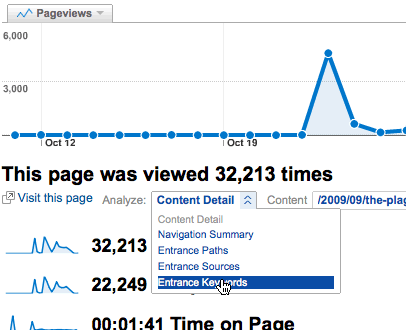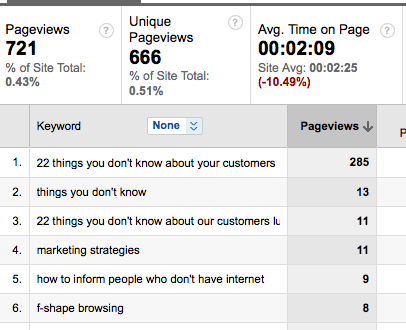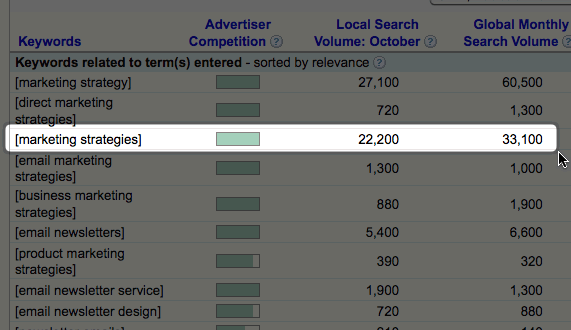I’m speaking at Pubcon tomorrow in the Real-World Content Creation Tactics session. I’m going to focus on how you avoid destroying copy with SEO, and how to do great analytics-centric SEO. If you know me, you know I rehearse, in part, by writing. So here you go – a preview of tomorrow’s talk.
“Write good content, and they will come.”
Humbug.
You’d better have more of a strategy than that. Ian’s Cynical Version of the same rule is:
“Write the right good content, and they’ll eventually show up.”
It’s that critical word – right – that can make or break your Internet marketing efforts. So here’s a formula I’ve used for years to make sure I’m writing what my audience actually wants to read:
Step 1: Figure out what’s got their attention
What’s bringing people to your site, and where do they go when they get there? You can figure it out with analytics.
If you don’t have traffic reports of any kind, bookmark this article. Then go kick your webmaster’s arse, get traffic reporting set up, and come back in about 4 weeks.
- Open your traffic reporting tool. I’m going to use Google Analytics in this example. Pick a date range that will get you a decent chunk of page traffic. Use your gut here – there’s no set ideal number.
- Go to the Top Content Report. This report lists the most popular pages on your site (it might be called ‘Top Pages’ or ‘Most viewed pages’). To find this report in Google Analytics, click ‘Content >> Top Content’.
- Click the most popular page (besides your home page).
- Then list the keywords driving traffic to this page. In Google Analytics, you do that by selecting ‘Entrance Keywords’ from the ‘Analyze’ drop down:

- Take a look at the time on site and exit rate for those keywords. If they’re average or close to average, then they’re probably a good starting point.
You can get a lot fancier with conversions and such, but I’m sticking with the simplest version of this procedure for now.
Step 2: Find your juiciest keywords
Now you have a nice, neat list of keywords that drive traffic to the busiest page on your site:

Copy the top 5-10 terms into a tool like the Google Adwords External Keywords Tool. You can delete any terms that are clearly branded. In this case, I removed ’22 things you don’t know about your customers’, because that’s the article title. I don’t need to optimize for that.
In my case, the best phrase generating traffic is ‘marketing strategies’. If I have a prayer of ranking for it, I need to pursue it:

Now I know: My post is getting traffic from ‘marketing strategies’. It’s decent quality traffic. I want more.
Step 3: Figure out if you have a chance
Can I compete for a top ranking for ‘marketing strategies’? A quick look at the Google rankings tells me I can dream: My home page is actually high on page 2 for the phrase. Click here to see the rankings.
The specific post doesn’t show up in the first five pages. But what the hell. I’m an optimist. Cough. I’ll take a shot at it.
Step 4: Optimize!
Armed with this knowledge, I’m going to do a few things:
- Change the title tag to start with ‘Internet Marketing Strategy’, so I’m a tad more relevant;
- Tweak the first paragraph’s copy a little so that it has the keyphrase in it;
- Build links to the post from other pages on my blog;
- Potentially write more marketing strategy posts and link them to this page, too.
Voila. Analytics-driven SEO.
Analytics-driven means customer-centric
This method is never perfect, of course. Once you make your changes, keep a close eye on how traffic patterns change. I also encourage you to learn more keyword research tools, so you can more thoroughly check on the phrases you select.
The real beauty of this strategy: You’re just doing what your customers tell you to do. Worst case, it should improve the page’s ‘curb appeal’ when visitors arrive.
Related Links and Stuff
- Go read that marketing strategy article I write about in this post.
- Learn your keyword research tools.
- Follow me on Twitter.
- Subscribe to this blog.
- Come see the content tactics session at Pubcon tomorrow. I’ve got pictures of moles. The furry clawed kind. Not the furry face kind.










Great stuff here Ian. Joost de Valk had a post a while back about creating filters in Google Analytics to isolate out organic search traffic that your site gets from keywords where you rank on page 2.
This is similar to what you are doing here, and looking at keywords that you are 1) already pretty close for, and 2) bring traffic when you are on the second page – so you know they have search volume… anyhow by combining those two I think you have some high-priority keywords where a little on-page tweaking and maybe a minor link building effort can really produce big ROI.
As an SEO agency owner, this is probably the biggest thing I feel like we need to do more of – its low hanging fruit just waiting to be picked.
Good luck with your Pubcon presentation!
Really like this strategy! I have just updated a number of my pages following the instructions above.
Thanks!
Great points on combining analytics with SEO analysis. We always say “make data driven decisions”. The best SEO strategies use data for planning rather than guesses. Figure out what’s working and what’s not and optimize. Rinse & repeat
Recently i launched my own website. Naively i just assumed you put your site on the web and away you go.I knew nothing about SEO but i soon learned,it was a case of having to. The first month i had no idea really what i was supposed to be doing in getting my site noticed by the search engines. When the penny finally dropped and i came to realize about keywords and especially anchor text key words in blogs and replying to blogs, also i found one of the most important tools is original content on your site, it came quite easily in boosting my page position. When i started out my site appeared on page 27 of Google and this was out of 60 million results that Google pulled up. Within 10 weeks i am now on page 1. My other key words pulled up over 240 million results and i am currently on page 2 for this. I have had no training in SEO and i have not paid for a single thing in terms of links or help from any SEO companies. It is boring and tedious but you just have to stick at it, day in and day out. At first the rewards come slow and there are times when you actually think you arn’t making any ground but after 3-4 weeks i did start to notice my position gradually improving and this then gives you the boost to stick at it. It’s not rocket science and does not requires any great skill to accomplish, just very long winded at best. You only get out what you put in and this is just the way of the world. I havent mentioned what my site is called incase it comes across as spamming something that i am certainly against.
Too many people ignore the obvious when it comes to SEO and they miss what is right in front of their nose!
I use Google Analytics and I will definitely start using it more effectively after reading this. Before I go killing myself to write new content, I will review the content I already have and see if I can improve my traffic that way.
Thanks for the great post!
Thanks for the reminder about keyword research. Good stuff.
Great points on combining analytics with SEO analysis. We always say “make data driven decisions”. The best SEO strategies use data for planning rather than guesses. Figure out what’s working and what’s not and optimize. Rinse & repeat